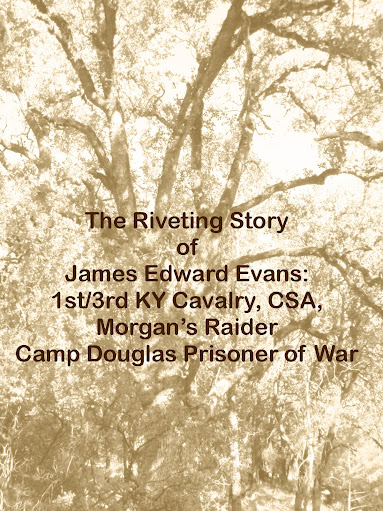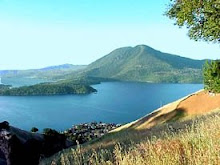“As near they drew and nearer my heart beat fast in alarm;
But still I stood in the doorway, with baby on my arm.
They came; they passed; with spur and whip in haste they sped along;
Morgan, Morgan the raider, and his band six hundred strong.” [i]
Spirits ran high amid the Union soldiers pursuing Morgan.
“Friday July 10
Rebs reported ten miles ahead and we are after them again. Pass through Corydon. Enthusiastic cheering by citizens. Joined by a lot of squirrel hunters of Indiana. Travel till after dark. Camped five miles from Salem.”
~ Charles W. Durling, Company G, 45th Ohio Infantry [ii]
Union leadership however was in a state of disharmony. It was difficult to know any fact with certainty. Tracking the movements and progress of both Morgan and the Union troops pursuing him was becoming a nightmarish task. Unreliable reports, exaggerated counts, long distances, flooded rivers, downed telegraph wires, missing couriers, spies, wire taps, and an alcoholic general who refused to receive orders complicated an already marginally functioning system.
“July 10, 1863
General Boyle, Louisville, KY:
What is the state of affairs this morning? Do you hear anything of Hobson or Judah? Has the battery arrived from here yet? Have the troops from below arrived, and where is Colonel Moore? Don’t fail to send back the Seventy-first Indiana and the battery if you become satisfied that the rebels are moving north. Hobson must pursue rapidly and overtake Morgan. Report soon. Answer in cipher.
A. E. Burnside,
Major-General.” [iii]
The nature of the movement of 2,500 cavalrymen is hard for the modern, civilian mind to comprehend. At times Morgan’s Men were spread in a long serpentine file over a single road much like the current of an impressive river. On other days, the mighty surge of men broke into slender rivulets randomly streaming across the countryside, and flowing along the paths of least resistance. By separating into multiple groups, the men could more easily search for fresh horses, seek food, and confuse the Union scout’s knowledge as to which the direction the main column might be traveling.
Thus, leaving Salem, Morgan broke apart his force. Morgan and his command moved toward Palmyra while he sent one group off to forage in Paoli and another to Greenville.
When the main force of Morgan’s Raiders came into view near Palmyra, 350 frightened militiamen selected to retreat. Again Morgan divided his men sending one group off to destroy a railroad bridge and another off to scout Salem.
“July 10. Attacked Palmyra and captured a small force of the enemy. Then moved on Salem, where after some fighting, a considerable force surrendered to us. Here we destroyed heavy supplies, a depot, and several bridges. Then we captured Canton, tore up the railroad, tore down the telegraph, and then rapidly moved on, like an irresistible storm, to the vicinity of Vienna, where, for a brief period, we bivouacked. The citizens seemed frightened almost to death, for Federal papers have published the wildest tales about us. The Governors of Indiana and Ohio have ordered out all able-bodied men, and we have already fought decrepit, white-haired age and buoyant, blithe boyhood.”
~ Lt. Col. James B. McCreary, 11th Kentucky Cavalry CSA [iv]
Morgan was in good humor.
“Give the lady enough cloth to make herself a dress. Give her the whole bolt. She’ll need it!”
~ John Hunt Morgan upon witnessing a stout Indiana matron scolding his cavalry as they past her home [v]
The Union leadership however, were feeling rather miffed.
“ Louisville, July 10 , 1863
General Hartsuff:
Wires all cut in Indiana. Morgan’s force reached the railroad. I cannot communicate with General Burnside. Can you inform me when Colonel Sanders will reach Eminence? I will send special train or messenger to him. I have sent courier to General Judah to move to Elizabethtown, and report his arrival to me.
J. T. Boyle,
Brigadier-General.” [vi]
General Henry M. Judah was a notorious drunkard. His leadership ability had been under question since 1854 when he was found to be too inebriated to lead his men against a group of Native Americans. His unseemly behavior was recorded by Lieutenant George Crook:
"It seemed that the rear guard had gotten some whiskey, and were all drunk, and scattered for at least 10 miles back. Judah was so drunk that be had to be lifted from his horse when the rear guard straggled into camp. The next day he was sick all day with the delirium tremens.”
Judah’s performance through the Civil War was dismal (save his remarkably humanitarian gesture in Georgia wherein he issued rations to straving captives) and horrifically mared by his alcoholism.
Jeremiah T. Boyle was also a paradox. A slave-owning Kentuckian, Boyle had argued for gradual emancipation. Yet, Boyle had sided with theUnion and after providing military service which included fighting in the Battle of Shiloh, he was appointed Military Governor of Kentucky by Abraham Lincoln in May of 1862. By July of 1863, Boyle had already dispatched Federal troops several times to combat the raids by led John Hunt Mogan. In fighting to save the Union, Boyle, very much like the persident he served, had a direct hand in destroying both resources and lives in his beloved home state.
Disputes between Judah and Boyles only made it easier for Morgan to keep his cavalry ahead of the pursuing Union forces.
Just beyond Palmyra Morgan split his men into three parties in order to secure food, procure horses and confuse the Union forces trying to both follow and predict his movements.
“It must be borne in mind that in Morgan’s sweep across three States, a distance of nearly one thousand miles, he swept his line of march, and for some distance on each side, almost clean of horses, giving his command almost daily remounts, leaving us, his pursuers, to secure our remounts with extreme difficulty.
~ Captain Theodore F. Allen, Seventh Ohio Cavalry [vii]
While crossing Blue River near New Pekin, Captain William J. Davis and his men were captured by a group consisting of the 73rd Indiana Infantry and a detachment of the 5th U.S. Regulars. Davis was taken to New Albany in held the county jail.
Boyles still wasn’t entirely certain of the position of Morgan’s position.
Indianapolis, July 12, 1863.
General Boyle:
The following just received:
Since my last, Colonel Heffner, at Salem, telegraphs me that skirmish took place at Pekin, in which we killed 1 and wounded 5, and took about 20 prisoners. My pickets have been twice disturbed tonight, and cannon have been distinctly heard in the direction of Salem about half an hour ago.
W. C. Kise,
Colonel, Commanding at Mitchell
O. B. Willcox.” [viii]
The splintered groups of Raiders rejoined in Salem. Upon entering the town, Morgan agreed not to destroy the town’s mills in exchange for a payment of $1,000 per mill. However, the depot, railcars, water tower, and two bridges were destroyed. And all the saloons looted of their whiskey. After the whiskey, the plundering grew out of hand as men sought presents for their wives and sweethearts.. One man was seen carrying a cage full of canaries, another carried pairs of ice skates; still others tied bolts of calico to their saddles. On the way to Canton the Raiders tore up railroad tracks and tore down telegraph wires.[ix]
“INDIANAPOLIS, July 10. – The rebels captured Salem this morning, burned the depot of the Louisville and Chicago Railroad and took 500 home guards prisoners. No particulars of the fight received. A prisoners who escaped, reached Seymour this evening, says General Morgan’s forces, 7,000 strong with six pieces of artillery, left Salem this afternoon, moving eastward; supposed purpose to strike the Indianapolis and Louisville Railroad at Vienna and Seymour. General Hobson, with forty-five hundred cavalry, was at noon today in close pursuit, being fifteen miles in the rear. When last heard from, the rebels were at Canton. The home guards were retarding the progress of the rebels by felling trees and bushwhacking. Brigadier-General Carrington has assumed command of the Indiana Militia, and has already assigned a large portion of the companies to report to regiments and brigades. At least fifty thousand will have reported for duty tomorrow morning.
~ The Cincinnati Daily Enquirer [x]
“Friday July 10th, 1863. Weather clear. We fed our horses and got some meat and bread. By this time our regiment came up and we took our places in ranks. Our regiment was in the rear of the first Brigade and in advance of the second Brigade. The city of Salem, Ind. surrendered before we got there without much opposition. The courthouse and pavement was crowded with home guard prisoners. They were being paroled and turned loose as fast as possible. We got some fresh horses here. I gave up my broken down C. S. horse for a heavy made road pony. Some of our men rigged up a new wagon with new harness and fresh horses and filled it with captured ammunition.”
~ Curtis R. Burke, 14th Kentucky Calvary, Co. B. [xi]
Again Morgan divided his men. One column dipped southward, crossing the Jeffersonville and Indianapolis Railroad at Henryville. The other traveled through Canton, New Philadelphia and Leota.
Each day he [Morgan] and his men spent an average of 21 hours in the saddle. [xii]
This hurried pace left the Union leadership frantically telegraphing each other for any information on Morgan.
“Louisville, July 10, 1863 – 4 p. m.
General Hartsuff:
Morgan passed from Corydon toward Salem, which he occupied today; part of town was fired. Last reposts that he moved northward from there. I believe unless he concludes to go to National road, and go through Indiana, and thence to Western Virginia, he will endeavor to cross above this city, and take Madison at Grass Flats, where he will attempt to ford. Hobson is in pursuit. Don’t know where General Judah is. If Morgan crosses above, he will move for Frankfort, Harrodsburg, or Lexington. I will advise you of his movements as I am informed.
J. T. Boyle,
Brigadier-General” [xiii]
“Mitchell, Ind., July 10, 1863
General Boyle:
Morgan is now north of Salem. He came near capturing one of our trains after troops. Salem is reported on fire.
Budd,
Captain.” [xiv]
“Salem, Ind., July 11, 1863.
General Boyle:
I am here with my command; marched 50 miles yesterday. Morgan has gone in direction of Madison. If he can be checked up in front, I will attack him in rear. Fresh horses cannot be procured in this part of the state. My men have all been fed, and will push on, if you do not order otherwise.
E. H. Hobson,
Brigadier-General.” [xv]
ENDNOTES
[i] Woolson, Constance Fennimore. “Kentucky Belle.”
[ii] Diary of Charles W. Durling.
[iii] “Official Records of the Union and Confederate Armies,” Part I –Reports, p.718.
[iv] Diary of James B. McCreary.
[v] Souder, Marjorie Ann Martin. Outdoor Indiana, Vol. 40, No. 6, July-August 1975, p. 34.
[vi] “Official Records of the Union and Confederate Armies,” Part I –Reports, pages 718 – 719.
[vii] Allen, Theodore F. “In Pursuit of John Morgan,” Sketches of War History 1861-1865, Papers prepared for the Commandery of the Sate of Ohio, Military Order of the Loyal Legion of the United States 1896 -1903, pages 230-231.
[viii] “Official Records of the Union and Confederate Armies,” Part I –Reports, p.732.
[ix] Student Tour Guide, John Hunt Morgan Heritage Trail 1863.
[x] Daily Cincinnati Enquirer, July 11, 1863.
[xi] Journal of Curtis R. Burke.
[xii] The International Museum of the Horse http://www.kyhorsepark.com/museum/history.php?chapter=81
[xiii] “Official Records of the Union and Confederate Armies,” Part I –Reports, p.719.
[xiv] “Official Records of the Union and Confederate Armies,” Part I –Reports, p.723.
[xv] “Official Records of the Union and Confederate Armies,” Part I –Reports, p.724.
Subscribe to:
Post Comments (Atom)





No comments:
Post a Comment